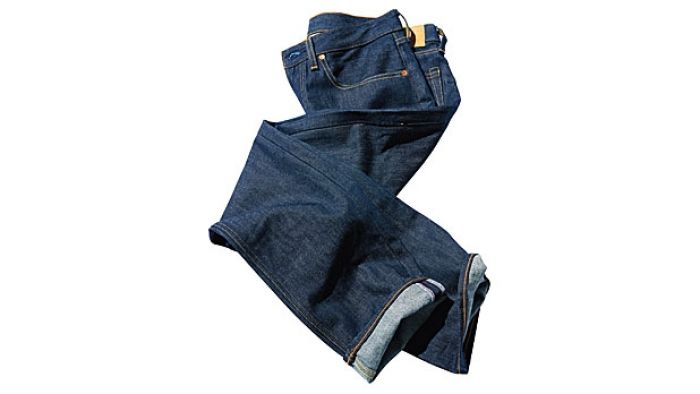A Buyer's Guide to Selvedge Jeans
Credit: Photograph by Ben Alsop
Buying jeans used to be simple — know your waist, length, and whether you wanted them to fit over your cowboy boots. But in recent years, selvedge denim, a higher quality and more durable fabric, has escaped the confines of specialty stores (and their $500 price tags) and is now available everywhere — even Gap sells a $100 pair. Which is great. They're stronger, break in to a perfect fit, and have those deep, natural fades. But navigating the options can be overwhelming: selecting the cut, finding your fit with the initially stiffer fabric, and ensuring that you don't shrink them in the wash. "Selvedge denim looks better with wear," says Victor Lytvinenko, co-founder of Raleigh Denim. "It costs more, but you're getting more for your money." Here's how to spend it wisely and get the right pair.
1. Know the Difference Between Raw and SelvedgeThe two terms are not synonymous. Selvedge refers to denim that has been woven on shuttle looms, resulting in a tightly woven band running up the fabric's edge – preventing it from fraying. Raw, on the other hand, is any fabric that hasn't been distressed, washed, rinsed, or otherwise treated to make it feel soft or look artificially aged. Although most selvedge jeans are sold raw, not all of them are. RRL's jeans are made from a high-quality selvedge denim, but since they're often pre-washed, they're not considered raw.
RELATED: The Ultimate Guide to Denim
2. Buy SnugSelvedge denim stretches with time, so buy a slim straight-cut pair a size smaller than usual. "You want a pair that's a bit snug at first in the waist," says Paul O'Neill, senior designer at Levi's Vintage Clothing. Find jeans with just enough room to squeeze a finger between your body and the waistband. "That way, they'll stretch to the perfect size after a few weeks of wear." As you break them in, the patterns will fade along your body's contours to create a worn look unattainable with regular jeans — especially if you resist washing them for a few months.
3. Know Your WeightDenim is measured in ounces per yard, and can range from as light as eight ounces to as heavy as 32. Weight doesn't affect price much but can affect comfort. "Lightweight jeans are more comfortable during the summer," says David Shuck, managing editor of the Rawr Denim website. "But heavier ones can last longer and give you sharper contrast fades." Buy midweight jeans made from an 11- to 14-ounce cotton; they're ideal for year-round wear and still give sharp fades.
4. Don't Be Afraid to Cuff"I wear mine plain during the wintertime but will roll them up twice with a one-inch cuff during the summer," Lytvinenko says. "It allows the breeze to blow through." Cuffing also allows you to show the jeans' distinctive line of selvedge — the pop of textured fabric can add a little extra contrast to your look. When rolling, have the cuff end just above your ankles.
5. Wash RarelyWear your jeans hard and as long as possible before washing. When washed, the fabric loses its indigo dye — resulting in less of the high-contrast fades you want from natural wear. When you do clean your jeans, turn them inside out and put them in a cold wash with gentle detergent. Don't machine dry: It can shrink the fabric and fade color.
RELATED: The Best New Jeans for Men
6. The Difference Between $100 and $300 Jeans?Higher-priced selvedge jeans tend to come from the U.S. and Japan – Raleigh Denim's jeans are 100 percent made in North Carolina with vintage sewing machines – and can feel more distinctive than their mass-produced competition from China (despite roughly identical manufacturing processes). More-expensive jeans may also have unique details like aged iron rivets and may use denim with a unique texture or weave. (In 2011 the Japanese brand Momotaro sold a pair of handwoven jeans for $2000; the premium was due to the use of a loom traditionally tasked for making kimonos.) But in terms of fit, comfort, and durability, the extra money doesn't necessarily pay off. "For your first pair of selvedge jeans, I recommend getting something that's affordable," says Shuck. "A lot of the higher-end stuff comes with detailing that only enthusiasts care about."
Get the latest in gear, fitness, travel & more delivered directly to your inbox. Sign up now for the Men’s Journal newsletter.
